Study on the Influence of Steel Fiber Distribution on the Mechanical Properties of Perfobond Leiste (PBL) Shear Connectors
Abstract
:1. Introduction
2. Materials and Methods
2.1. Material Properties
2.2. Specimen Design
2.3. Preparation and Loading
3. Finite Element Analysis
3.1. Build Finite Element Model
3.2. Material Properties and Constitutive Definitions
4. Comparative Analysis of Tests and Finite Elements
4.1. Load-Slip Curve
4.2. Specimen Damage
5. Steel Fiber Distribution Impact Analysis
5.1. Parameter Design
5.2. Analysis of Results
5.3. Shear Force and Flow Direction
6. Conclusions
Author Contributions
Funding
Institutional Review Board Statement
Informed Consent Statement
Data Availability Statement
Conflicts of Interest
References
- Du, H.; Hu, X.; Shi, D.; Fang, B. Effect of reinforcement on the strength of the web opening in steel-concrete composite beam. Eng. Struct. 2021, 235, 112038. [Google Scholar] [CrossRef]
- Hamoda, A.; Emara, M.; Mansour, W. Behavior of steel I-beam embedded in normal and steel fiber reinforced concrete incorporating demountable bolted connectors. Compos. B Eng. 2019, 174, 106996. [Google Scholar] [CrossRef]
- Wu, F.; Liu, S.; Xue, C.; Yang, K.; Feng, Y.; Zhang, H. Experimental study on the mechanical properties of perfobond rib shear connectors with steel fiber high strength concrete. Materials 2021, 14, 3345. [Google Scholar] [CrossRef] [PubMed]
- Zhou, Y.C.; Wang, D.D. Analysis on shear-capacity of PBL shear connectors based on finite element analysis method. Highway 2022, 67, 109–113. (In Chinese) [Google Scholar]
- Ollgaard, J.G. Shear strength of stud connectors in lightweight and normal weight concrete. AISC Eng. J. 1971, 71–10. [Google Scholar]
- Chen, Y.; Fu, K.; Jiang, B. Modelling localised progressive failure of composite sandwich panels under in-plane compression. Thin Wall Struct. 2023, 184, 110552. [Google Scholar] [CrossRef]
- Wei, G.K.; Fu, K.K.; Chen, Y. Crashworthiness and failure analyses of FRP composite tubes under low velocity transverse impact. Sustainability 2023, 15, 56. [Google Scholar] [CrossRef]
- Yang, T.; Zhou, X.; Liu, Y.Q. Flexural performance of prefabricated composite beams with grouped bolt shear connectors under positive bending moments. Eng. Struct. 2023, 277, 115387. [Google Scholar] [CrossRef]
- Leonhardt, E.F.; Andra, W.; Andra, H.P.; Harre, W. New improved shear connector with high fatigue strength for composite structures. [Neues vorteilhaftes Verbundmittel fur stahlverbund-Tragwerke mit hoher Danerfestigkeit]. Beton-Und Stahlbetoubau 1987, 12, 325–331. [Google Scholar] [CrossRef]
- Cândido-martins, J.P.S.; Costa-neves, L.F.; Vellasco, P.C.G.S. Experimental evaluation of the structural response of Perfobond shear connectors. Eng. Struct. 2010, 32, 1976–1985. [Google Scholar] [CrossRef]
- Li, Y.; Zhang, Q.; Kamiński, P.; Deifalla, A.F.; Sufian, M.; Dyczko, A.; Ben Kahla, N.; Atig, M. Compressive strength of steel fiber-reinforced concrete employing supervised machine learning techniques. Materials 2022, 15, 4209. [Google Scholar] [CrossRef]
- Hrabova, K.; Lanik, J.; Lehner, P. Statistical and practical evaluation of the mechanical and fracture properties of steel fibre reinforced concrete. Buildings 2022, 12, 1082. [Google Scholar] [CrossRef]
- Hornakova, M.; Lehner, P. Analysis of Measured Parameters in Relation to the Amount of Fibre in Lightweight Red Ceramic Waste Aggregate Concrete. Mathematics 2022, 10, 229. [Google Scholar] [CrossRef]
- Amin, M.N.; Ahmad, W.; Khan, K.; Ahmad, A. Steel fiber-reinforced concrete: A systematic review of the research progress and knowledge mapping. Materials 2022, 15, 6155. [Google Scholar] [CrossRef] [PubMed]
- Xu, H.; Zhang, S.; Rong, B. Investigation on shear behavior of studs and PBL shear connectors in steel-concrete hybrid bridge girder. Structures 2022, 43, 1422–1435. [Google Scholar] [CrossRef]
- Vijayakumar, D.A.; Babu, D.D.L.V.; Prabakaran, M.E. Experimental study on shear behavior of different types of fibers in reinforced concrete beams. Int. Res. J. Eng. Technol. 2015, 2, 2. [Google Scholar]
- Naderi, S.; Zhang, M. 3D meso-scale modelling of tensile and compressive fracture behaviour of steel fibre reinforced concrete. Compos. Struct. 2022, 291, 115690. [Google Scholar] [CrossRef]
- Zhang, P.; Wang, C.; Gao, Z.; Wang, F. A review on fracture properties of steel fiber reinforced concrete. J. Build. Eng. 2023, 67, 105975. [Google Scholar] [CrossRef]
- Zhang, Y.; Liu, A.; Chen, B.; Zhang, J.; Pi, Y.-L.; Bradford, M.A. Experimental and numerical study of shear connection in composite beams of steel and steel-fibre reinforced concrete. Eng. Struct. 2020, 215, 110707. [Google Scholar] [CrossRef]
- Zhang, Y.; Chen, B.; Liu, A.; Pi, Y.-L.; Zhang, J.; Wang, Y.; Zhong, L. Experimental study on shear behavior of high strength bolt connection in prefabricated steel-concrete composite beam. Compos. B Eng. 2019, 159, 481–489. [Google Scholar] [CrossRef]
- Zhang, D.M.; Zhang, X. Damage characteristics of steel fiber-reinforced concrete based on direct tensile test. China J. Highw. Transp. 2023, 36, 146–156. (In Chinese) [Google Scholar]
- Zhu, K.W.; Xu, Z.H.; Cao, Z.W.; Xu, W. Analysis of steel fiber randomly distributed concrete beams based on ABAQUS. In Proceedings of the 2nd International Conference on Civil Engineering, Suzhou, China, 25–26 July 2017. (In Chinese). [Google Scholar]
- Raju, R.A.; Lim, S.; Akiyama, M.; Kageyama, T. Effects of concrete flow on the distribution and orientation of fibers and flexural behavior of steel fiber-reinforced self-compacting concrete beams. Constr. Build. Mater. 2020, 262, 119963. [Google Scholar] [CrossRef]
- Wu, K.; Chen, F.; Xu, F.Y.; Xu, J.N.; Xu, C. Experimental study on interfacial bonding property and energy dissipation capacity between shape steel and steel fiber reinforced concrete. China Civ. Eng. J. 2019, 52, 1–11+19. (In Chinese) [Google Scholar]
- Lu, D.; Zhang, L.Z.; Ji, T. Crack resistance of fiber reinforced concrete with different polypropylene fiber content by finite element analysis. Bull. Chin. Ceram. Soc. 2020, 39, 3191–3195+3202. (In Chinese) [Google Scholar]
- Yu, J.H.; Liu, Z.M.; Liu, M.; Li, C.Y. Finite element analysis of the effect of fibers on the crack resistance of concrete. China Concr. Cem. Prod. 2013, 201, 46–49. (In Chinese) [Google Scholar]
- Meng, S.; Jiao, C.; Ouyang, X.; Niu, Y.; Fu, J. Effect of steel fiber-volume fraction and distribution on flexural behavior of Ultra-high performance fiber reinforced concrete by digital image correlation technique. Constr. Build. Mater. 2022, 320, 126281. [Google Scholar] [CrossRef]
- Zandi, Y.; Husem, M.; Pul, S. Effect of Distribution and Orientation of Steel Fiber Reinforced Concrete. In Proceedings of the 4th WSEAS International Conference on Engineering Mechanics, Structures, Engineering Geology, Stevens Point, WI, USA, 14 July 2011; pp. 260–264. [Google Scholar]
- GB/T 50081-2019; Standard for Test Methods of Concrete Physical and Mechanical Properties. National Standard of the People’s Republic of China: Beijing, China, 2019.
- EN 1994-2, 2005; Eurocode 4-Design of Composite Steel and Concrete Structures-Part 2: General Rules and Rules for Bridges. European Committee for Standardization: Brussels, Belgium, 2005.
- Zhang, X.Z.; Bi, M.D.; Liu, T.J.; Sun, H.L.; Zhang, C.; Mu, R. Research progress in factors affecting fiber distribution in steel fiber concrete. J. Chin. Ceram. Soc. 2021, 49, 1732–1742. (In Chinese) [Google Scholar]
- Hognestad, E.; Hanson, N.W. Concrete stress distribution in ultimate strength design. ACI J. Proc. 1995, 52, 455–480. [Google Scholar]
- Zheng, S.J.; Liu, Y.Q. Experiment of initial shear stiffness of perfobond connector. China J. Highw. Transp. 2014, 27, 69–75. (In Chinese) [Google Scholar]

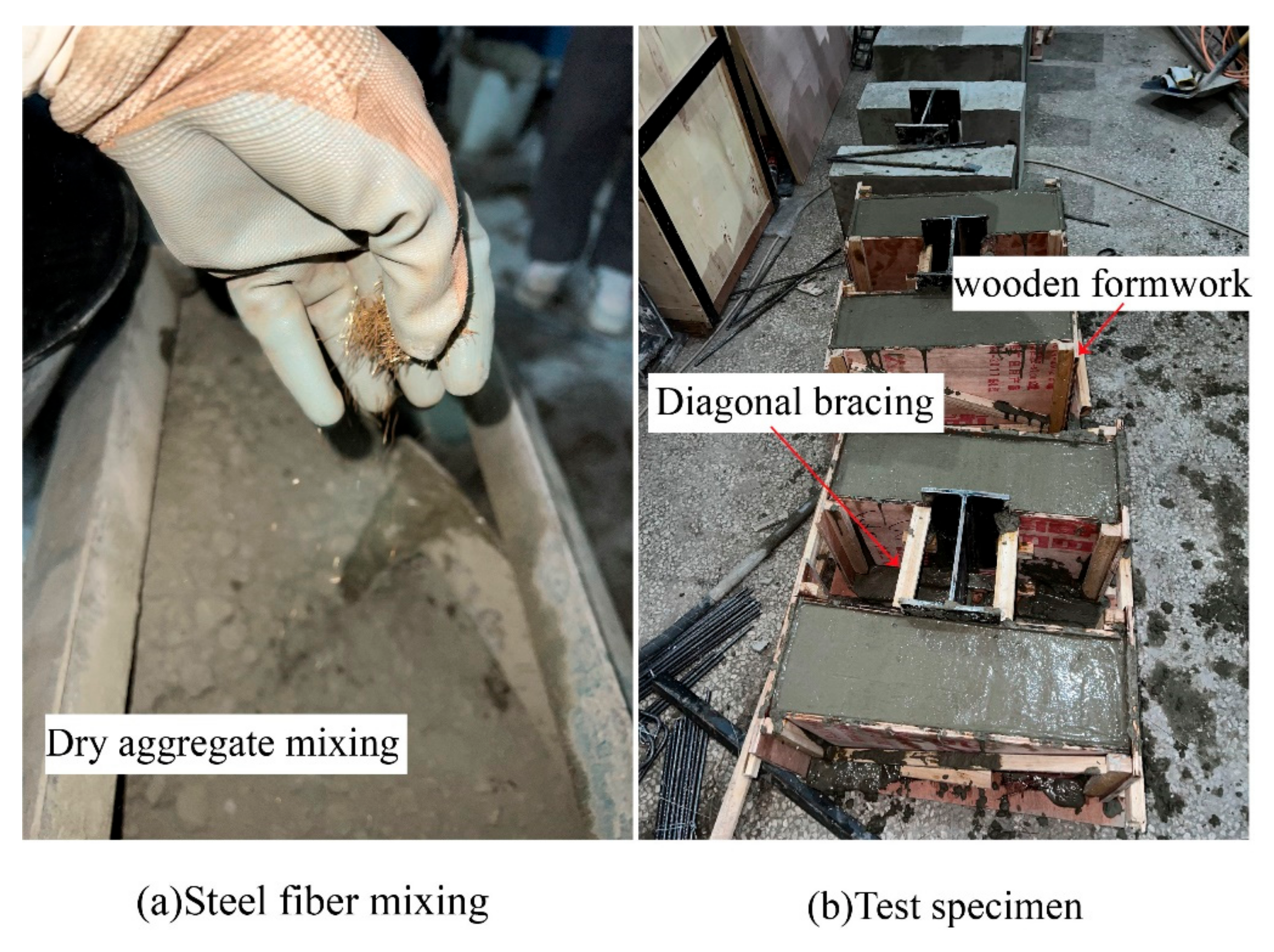
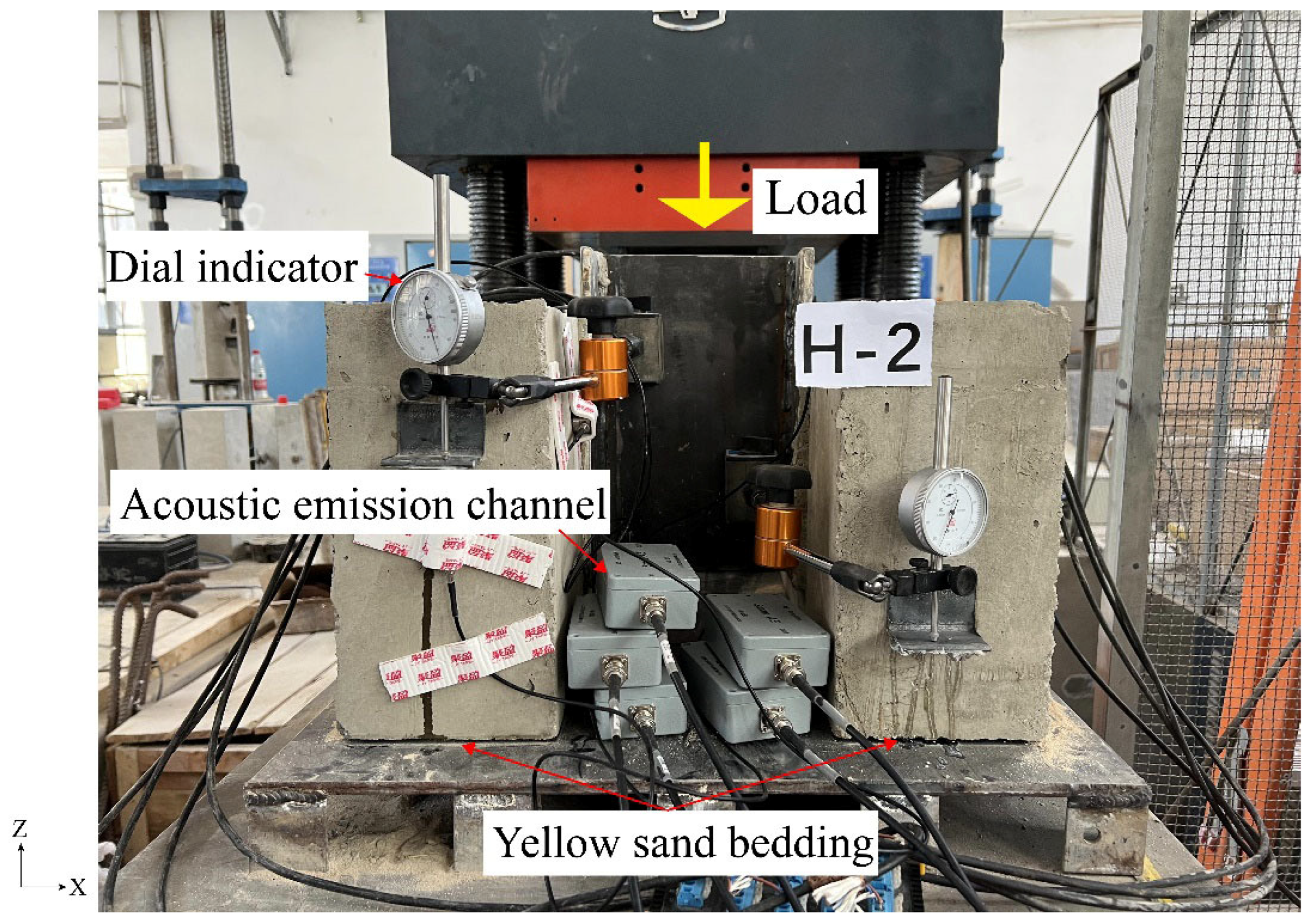
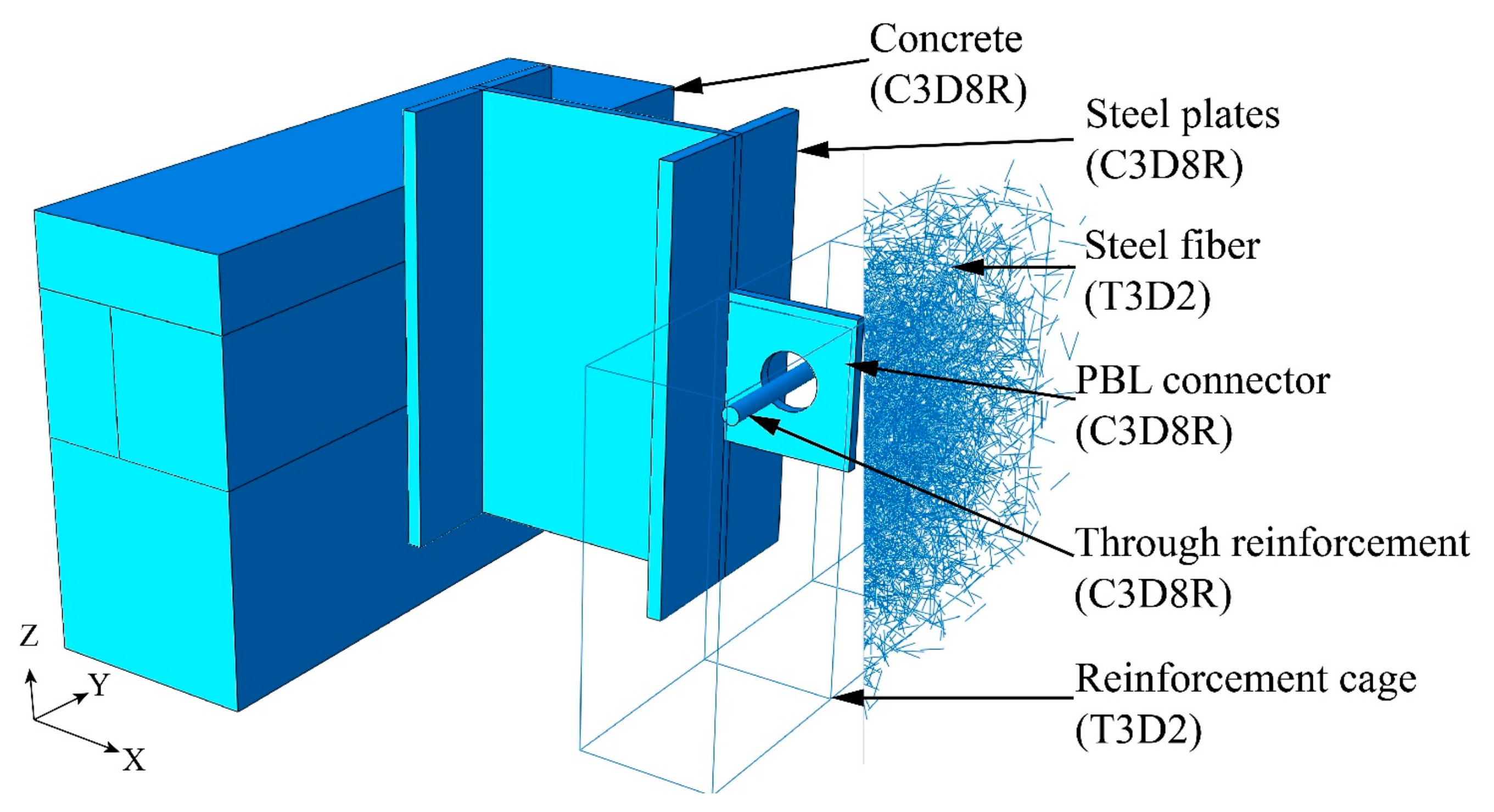


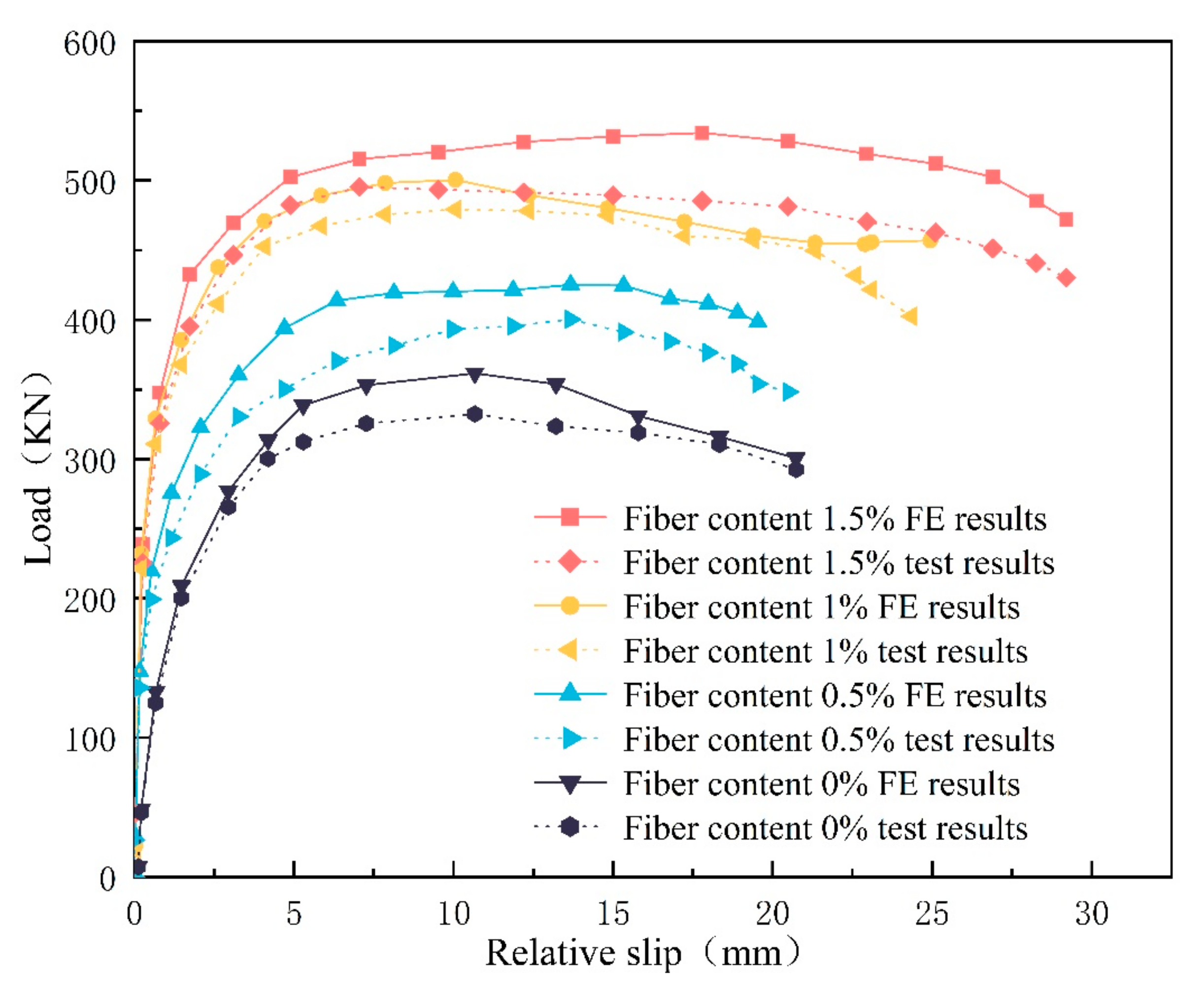
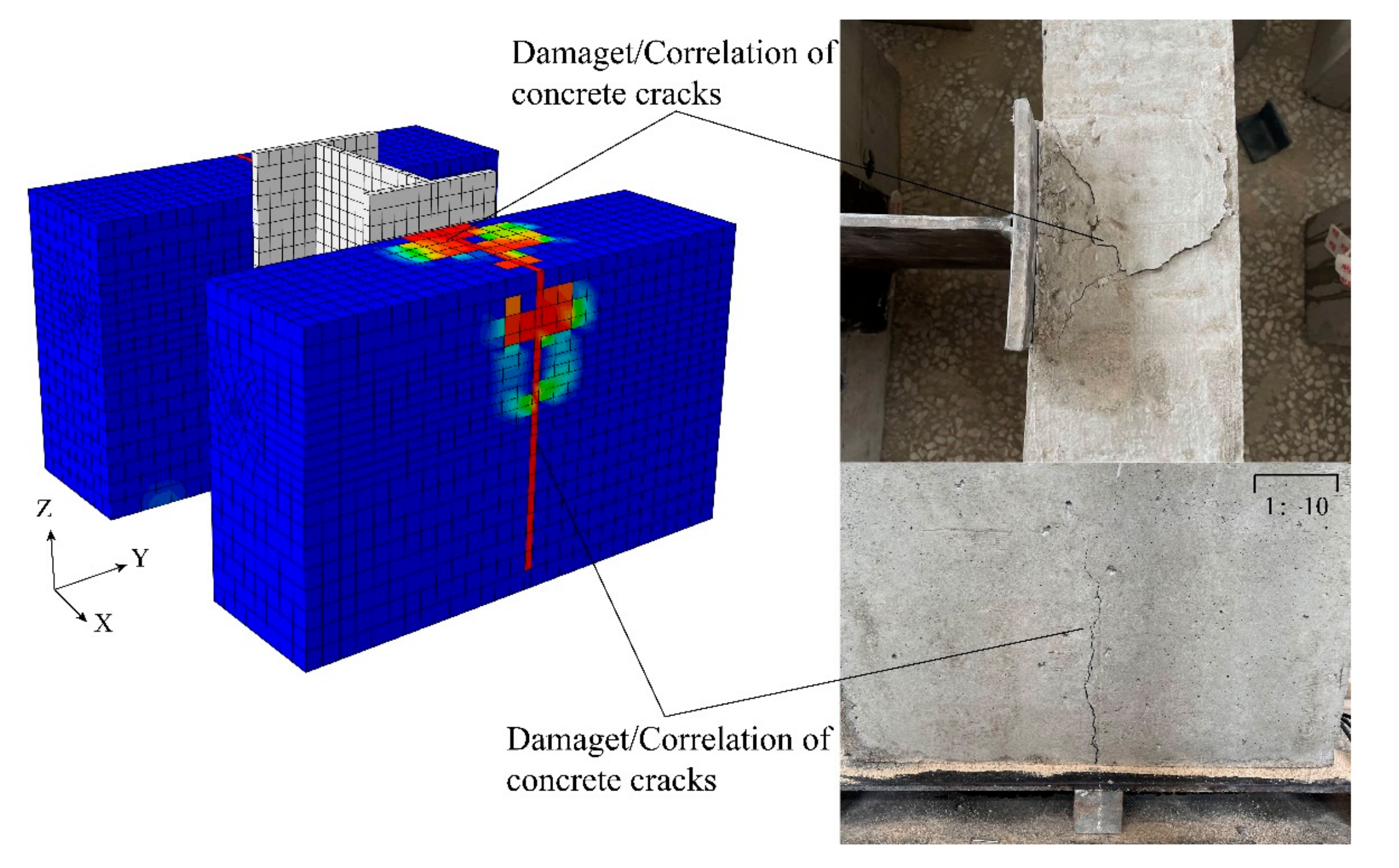


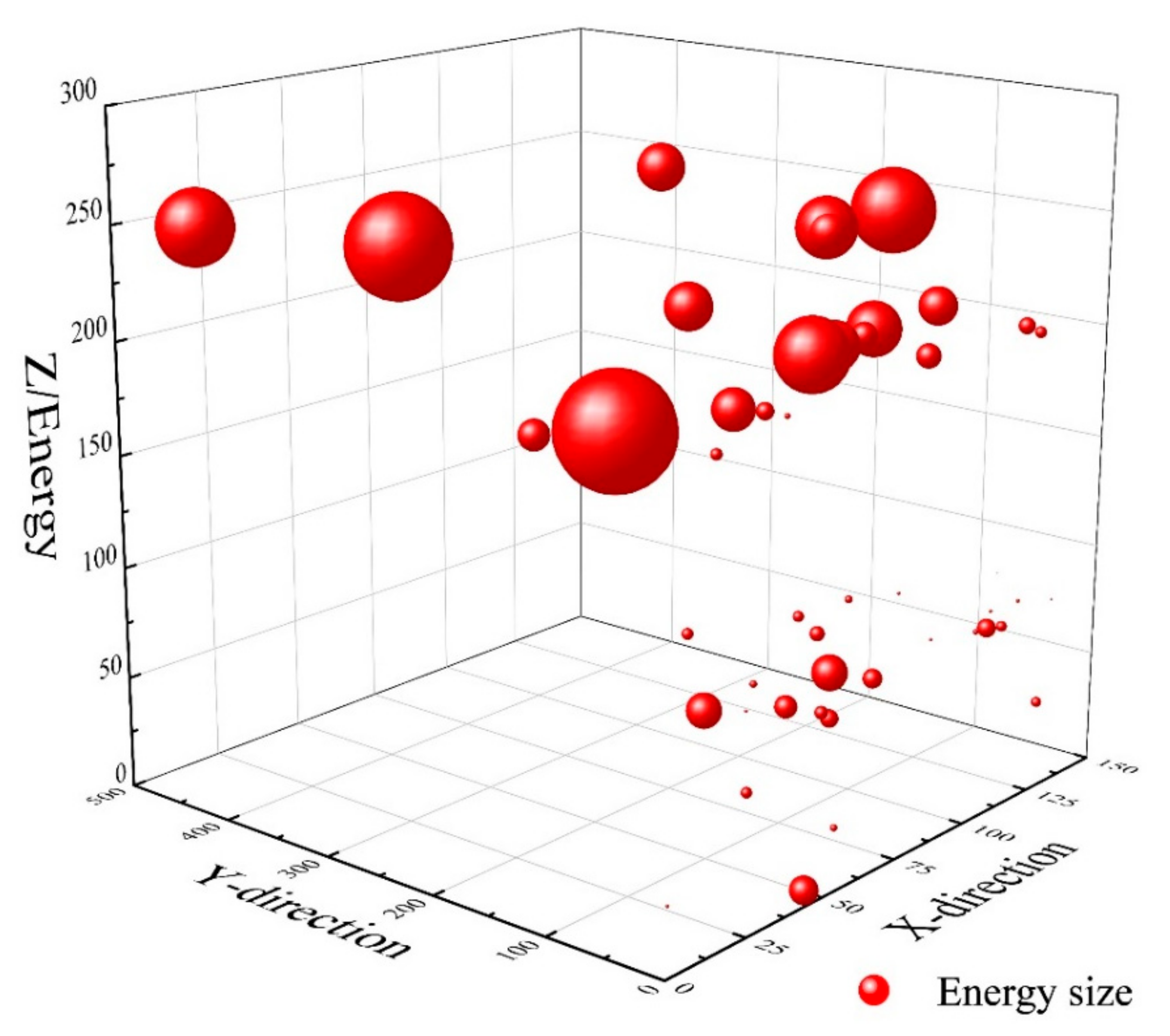
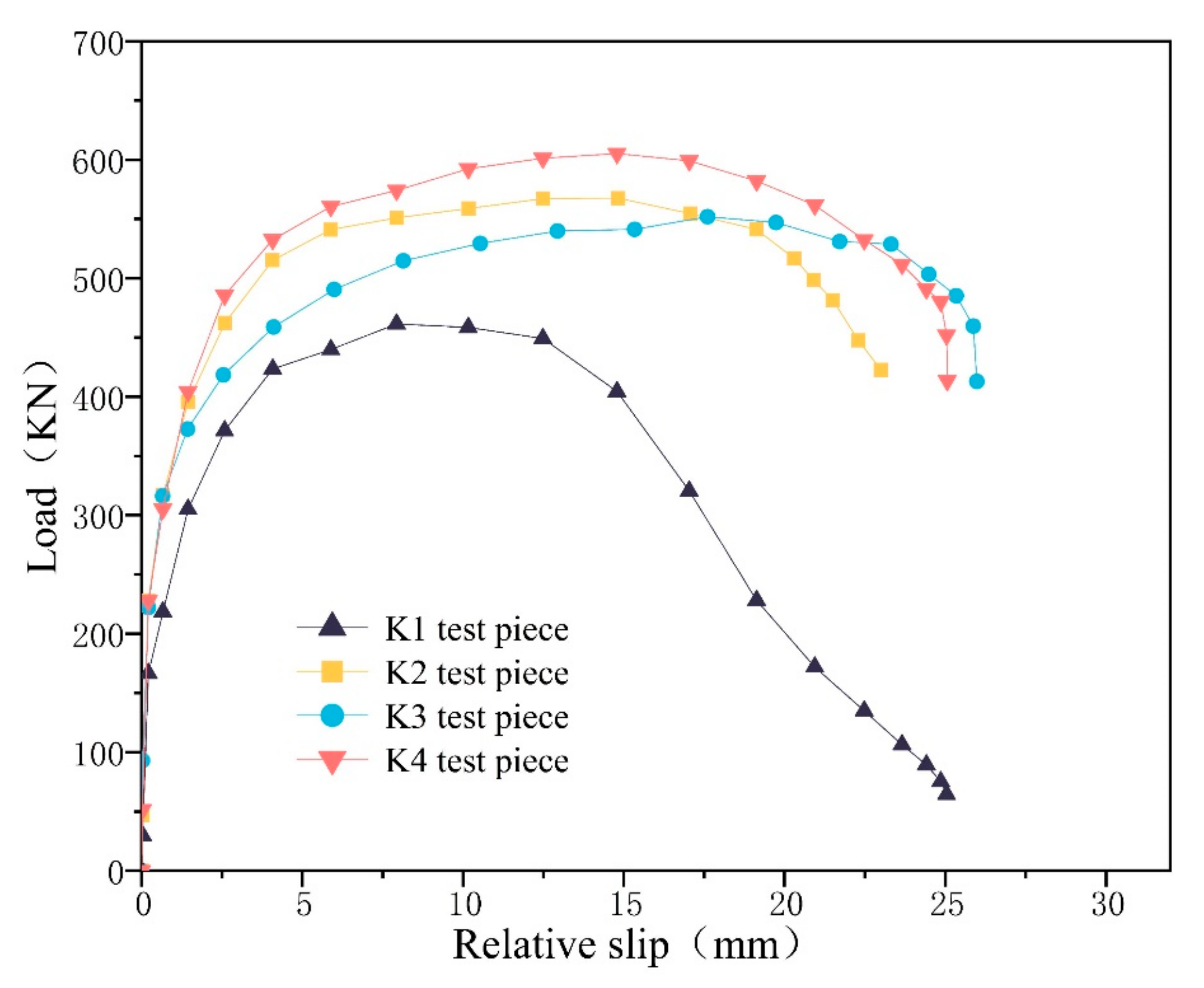



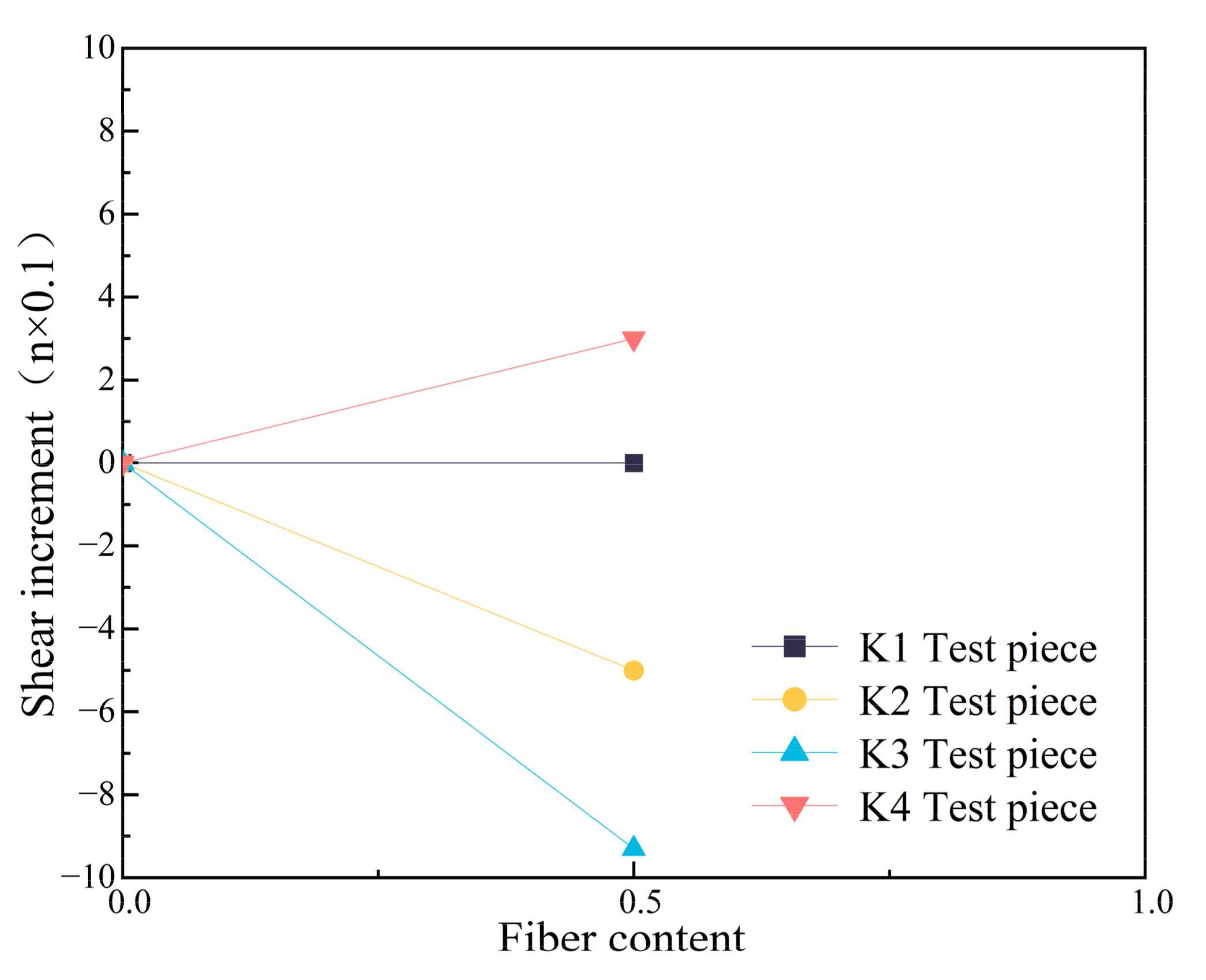


| Materials | /MPa | /MPa | /MPa | /MPa | /MPa |
|---|---|---|---|---|---|
| C40 | 42.12 | 3.25 × 104 | - | - | - |
| Q235 | - | - | 240.75 | 377 | 2.06 × 105 |
| Number | Concrete Size/mm | H-Shaped Steel Dimensions/mm | PBL Size/mm | Fiber Content |
|---|---|---|---|---|
| A1 | 500 × 150 × 300 | 90 × 100 | 90 × 100; R = 20 | 0% |
| H1 | 500 × 150 × 300 | 90 × 100 | 90 × 100; R = 20 | 0.5% |
| H2 | 500 × 150 × 300 | 90 × 100 | 90 × 100; R = 20 | 1% |
| H3 | 500 × 150 × 300 | 90 × 100 | 90 × 100; R = 20 | 1.5% |
| Specimen No. | Experimental Ultimate Bearing Capacity/kN | Finite Element Ultimate Bearing Capacity/kN | Slippage/mm | Error/kN | Error Ratio |
|---|---|---|---|---|---|
| A1 | 332 | 361 | 16.7 | 29 | 8.03% |
| H1 | 400 | 425 | 20.5 | 25 | 5.88% |
| H2 | 479 | 500 | 24.9 | 21 | 4.2% |
| H3 | 495 | 534 | 29.2 | 39 | 7.3% |
| Specimen No. | Fiber Orientation | Distribution Size/mm | Fiber Content |
|---|---|---|---|
| K1 | - | 90 × 200 × 200 | 0.5% |
| K2 | X | 150 × 200 × 200 | 0.5% |
| K3 | Y | 90 × 500 × 200 | 0.5% |
| K4 | Z | 90 × 200 × 300 | 0.5% |
| Specimen No. | Ultimate Bearing Capacity/kN | Slippage/mm | Increment/kN | Amplification |
|---|---|---|---|---|
| K1 | 567 | 18.7 | - | - |
| K2 | 551 | 22.5 | −16 | −2.8% |
| K3 | 461 | 12.5 | −106 | −18.7% |
| K4 | 605 | 19.3 | 38 | 6.7% |
Disclaimer/Publisher’s Note: The statements, opinions and data contained in all publications are solely those of the individual author(s) and contributor(s) and not of MDPI and/or the editor(s). MDPI and/or the editor(s) disclaim responsibility for any injury to people or property resulting from any ideas, methods, instructions or products referred to in the content. |
© 2023 by the authors. Licensee MDPI, Basel, Switzerland. This article is an open access article distributed under the terms and conditions of the Creative Commons Attribution (CC BY) license (https://creativecommons.org/licenses/by/4.0/).
Share and Cite
Zhang, Y.; Liao, W.; Fang, Y. Study on the Influence of Steel Fiber Distribution on the Mechanical Properties of Perfobond Leiste (PBL) Shear Connectors. Materials 2023, 16, 7387. https://doi.org/10.3390/ma16237387
Zhang Y, Liao W, Fang Y. Study on the Influence of Steel Fiber Distribution on the Mechanical Properties of Perfobond Leiste (PBL) Shear Connectors. Materials. 2023; 16(23):7387. https://doi.org/10.3390/ma16237387
Chicago/Turabian StyleZhang, Yurui, Wenyuan Liao, and Yuting Fang. 2023. "Study on the Influence of Steel Fiber Distribution on the Mechanical Properties of Perfobond Leiste (PBL) Shear Connectors" Materials 16, no. 23: 7387. https://doi.org/10.3390/ma16237387





